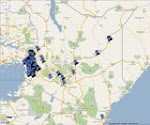by Moses Wakala and Christian Rieck
This is one of the working examples in Kenya ecological sanitation initiative. It however faces a few challenges that may need to be addressed following the initial informal set expectations. The major entry point in the school set by the donor and school management was to improve sanitation in school that had depreciated to a critical state. There seem to have been a verbal promise of rebuilding the toilets for the girls which were to be connected to the digester. The school management has not owned the system as fully implemented as they still wait for the toilet construction.
Status
The gas produced at a maximum pressure of 88-90 cm of water column is utilized in the kitchen cooking on two burners. It is mainly used in preparation of teacher’s food and a little cooking of students light food like breakfast. At the time of first visit, the baffle reactor that was an added component in treatment completed in May 2010 had not been put in full use. During the second visit, there seem to be a technical failure in the Baffle reactor that may demand some repair. There is a crack from the slab running downward. There is need for the donor to enhance the understanding that the system works well. Previously there was no reuse of the treated effluent. From the training on reuse, the school is now set to prepare the farm for this purpose.
The constructed wetland (vertical flow) showed serious problems with clogging when it received the effluent from the biogas digester directly. The reasons were the lack of appropriate manually operated batching of the waste water which was not effectively executed by the school management. Moreover the wetland area is too small in relation to the waste water load, hence it became clogged quickly. It has not been modified and reconnected to the DEWATS after installation of the ABR, since project time and funds were finished.
Challenges and lesson learned.
Giving high expectations to clients before project implementation may sound convincing but dangerous if the expectations are not met. Therefore the EcoSan experts should try as much as possible to be realistic when trying to promote this new technology. Gauging the client’s demands and needs should be the first duty done analytically by the expert before the implementation.
 |
| View of flush toilets (right), incinerator and two shower blocks behind |
 |
| Inside of girls toilets (with central flushing) |
 |
| Girls toilet cubicle (also used for showering) |
 |
Students dry their washed clothes on top of the biodigester,
which is underground |
 |
Top manhole of biogas digester and biogas piping visible in the attached testing and mail valve chamber
 |
Biogas piping and appliance in the kitchen (currently used
to cook the teachers food) |
 |
Kitchen set up with wood fuel stoves that
can be fitted with biogas burners |
|
 |
Staffs is enjoying the tea, that was cooked with
the biogas stove |
 |
This anaerobic baffled reactor (ABR) was added at a
later stage to the biogas digester (biogas settler). The
treated water is discharged into the woodlot, but not effectively
used by the school in their surrounding farm. |
 |
Constructed wetland (vertical flow) - problems with clogging - not
operation at the moment |
UDDT teachers toilets
The UDDT constructed has been left unused except the gents urinal. The toilets are kept locked. Checking the chambers indicated a slight earlier use that stopped before long. The toilet that was meant for the teachers is rarely used now. They have resorted to the pit latrine nearby. The only way forward is to have an exchange program for the teachers to a working EcoSan dry toilet because they seem not to have conceptualized the philosophy.
 |
UDDT toilet for teachers - on the left 1 male und 1 urinal - on the right 2 female
toilets - currently not used by teachers due to lack of training, only
the urinal and the handwash basins are used |
 |
Back side with UDDT with urine storage tank (300 liter) and
tap for withdrawal, the overflow of the urine tank goes
into underground infiltration within the farm |
Read more...




























